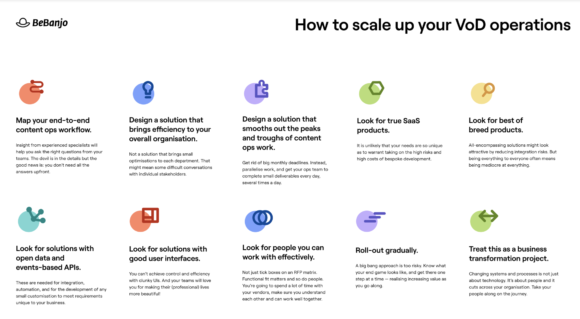M+E Connections

BeBanjo: Scaling up VOD Operations; Systems, Processes for High Efficiency
Story Highlights
This white paper explores the key challenges faced by ops teams in VOD businesses with high growth ambitions and offers some pointers to overcome them.
Your Video on Demand (VOD) service has great exclusive content, an exciting brand and a state-of-the-art app with flawless streaming. What could possibly go wrong? Content operations.
Content ops is responsible for executing your business’ content strategy – getting every title ready for distribution on every platform at the right time.
Content ops turn content plans into schedules. They prepare media, images and metadata. They validate rights and ultimately publish every title to every platform.
As your business expands into new territories and experiments with new streaming products (e.g. your own OTT platform and third-party syndication platforms) and business models (e.g. AVOD, SVOD, TVOD, EST) the demands placed on VOD operations increase. More and more schedules need to be created and maintained. Metadata needs to be prepared in more and more languages.
Rights need to be validated against increasingly complex licensing deals. Departments that were already stretched can find themselves overwhelmed as they’re asked to do more, typically with the same resources. Understandably, organisations will often favour consumer-facing expenditure (e.g. content acquisition, marketing, apps development…) over spending on internal operations.
 The results are bottlenecks that impact business as usual, stressed out teams that struggle to meet project deadlines and impede business growth, and an increase in errors that can negatively impact the company’s audiences and reputation. Depending on the service you operate, this can result in the loss of contracts, or – when you consider the ease with which consumers can hop from one service to another – much dreaded customer churn.
The results are bottlenecks that impact business as usual, stressed out teams that struggle to meet project deadlines and impede business growth, and an increase in errors that can negatively impact the company’s audiences and reputation. Depending on the service you operate, this can result in the loss of contracts, or – when you consider the ease with which consumers can hop from one service to another – much dreaded customer churn.
But it doesn’t have to be this way. Over a decade of experience in the industry has shown us that VOD businesses can massively scale up without overwhelming limited content ops teams.
In this white paper we will share our experience working with some of the world’s leading VoD businesses and outline:
1. The typical – and painful – journey organisations go through as they try to scale up their content operations
2. The behaviours and beliefs that contribute to their challenges
3. How to overcome those – with systems and processes to significantly scale up ops capabilities, without increasing headcount
The Tools of Your Trade are Stunting Your Growth
Since 2010 the VOD market has enjoyed significant, consistent growth, driven by widespread take-up of connected devices and – in the last couple of years – by shifts in consumer habits accelerated by the pandemic. Analysts suggest this upward trend will continue unabated, with many predicting an on-going Compound Annual Growth Rate (CAGR) of 10% until 2027.
This is great news for the industry. But something of a double-edged sword for the ops teams whose job it is to support the delivery of the services and to facilitate their growth. Not only do they need to get more content through their digital supply chains, they also need to remain nimble in a fast-changing media landscape. Streamers multiply and consolidate, business models (e.g. AVOD, SVOD) rise and decline and rise again, etc. Ops teams need to both run business-as-usual and support new growth initiatives.
While the specific circumstances of the challenges faced by operational teams can differ from business to business, having analysed the range of projects we’ve worked on, we’ve identified a typical organisational journey. It starts with spreadsheets, moves on to in-house software development, before embracing productised solutions.
Let’s look at each step of the journey and see what can be learnt to make your journey faster and easier.
We Need to Talk about Spreadsheets
On paper, tools like Microsoft Excel and Google Sheets look suitable for scheduling content, for managing rights, and for the preparation and distribution of metadata. Perhaps, early on in an organisation’s journey, they are.
These tools are cheap. They offer a simple user interface for the creation of data catalogues that can be easily manipulated and updated. With no business logic out of the box, they offer individuals and teams the flexibility to bend them to their will. The problem is, as the business scales, the very things that made them attractive are exactly the things that ultimately work against the business.
Data stored in applications with no business logic to validate its sanity produces all sorts of weird and wonderful errors. Manual effort for ops teams grows exponentially as new territories and new business models need to be supported. Each new distribution affiliate increases complexity with its own rules governing rights, catalogue choices and metadata requirements. Unstructured data representing plans, schedules and metadata remains siloed in spreadsheets – instead of flowing and informing all parts of the business that need it: research, compliance, finance, sales, marketing, etc. Expansion of the services requires constantly hiring new people with the unenviable job of copying-and-pasting from one spreadsheet to another.
In this model, ops teams try to do something very complex with a tool that doesn’t have the oversight or the collaborative features built in to manage the process effectively and efficiently for multiple stakeholders. Answering simple fundamental questions is difficult, e.g.
● “Does my SVOD schedule comply with the terms of my licensing deals?”
● “What Spanish metadata am I missing for publication of my schedules in Mexico next month?”
● “Do all my images for content distribution to AppleTV have the correct aspect ratio?”
● “How many hours of exclusive original comedy have I scheduled in the UK?”
● “Has all transcoded content due for delivery tomorrow been QC’d successfully?”
It requires searching multiple emails and multiple spreadsheets that then need to be cross-referenced. Worse, once you have the answer, it’s highly likely that the information you have is already out of date.
Is it any wonder that the teams involved become overwhelmed?
These issues can only be ignored for so long. At some point, operational issues appear that threaten the running of the business. It’s at this point that a plan is concocted to take the pressure off the embattled operations department and deliver greater efficiency. This typically triggers the development of an in-house system.
Enter In-House Systems Development!
Media companies often have significant internal technology capabilities. And in-house development of a bespoke software solution is often seen as a way out of Excel hell. After all, the organisation has expert knowledge of its own operational problems and should know better than anyone how to fix them, right? This thinking is sound, but in our experience, the resulting systems typically lead to a recurrence of exactly the same set of problems as you had before. Just a bit further down the road.
 The first issue isn’t the technical challenge per se, it’s the complexity of defining the problem before finding an optimal solution.
The first issue isn’t the technical challenge per se, it’s the complexity of defining the problem before finding an optimal solution.
When solving any complex issues or set of issues, the first and most important job is to clearly state what the actual problem is. It follows then, that if you can’t define the problem, you can’t solve it. Running VoD operations at scale, with its many moving parts is a particularly knotty business problem. Articulating it isn’t easy. Especially when it’s you that’s entangled in it. Ask 10 different people in your organisation what the problem is and you will get 10 different answers. To understand what’s really going wrong and define a scalable solution that solves the real issue, you need to understand what is happening across the entire workflow from end-to-end – with all its idiosyncrasies, co-dependencies, and bottlenecks.
The Challenge of Mapping Your Workflow
In the 10+ years we’ve been helping streamline VoD operations, we’ve rarely found a business with exhaustive and up-to-date documentation of systems and processes. Rather than establish a clearly defined workflow that’s owned and evolved centrally, it’s not unusual for working practices to be left to users to define.
The result is that every user has a different way of doing things. So, when we ask the business to describe their workflow, there’s never just one answer. This happens because as people get used to working with a particular tool, they find shortcuts that allow them to cut corners and workarounds to either help them get over obstacles or fill in for features that they need but aren’t available.
What workflow mapping usually makes apparent is overall inefficiency. The same information is repeated in multiple systems, with no clear system of record. The same tasks are being repeated by multiple teams. Often, each department acting in isolation has optimised its own systems and processes, to the detriment of overall organisational efficiency.
The Devil is in the Details
The second issue is the challenge of identifying all the different elements at play within the workflow and how they interact with each other. The devil is very much in the details here. For instance, how should your data model represent the HD and 4K distribution of the same film? The answer lies in 100 places throughout your organisation: how do your licensing deals treat HD vs. 4K? How does your media processing team transcode HD vs. 4K content? How does your consumer app present and price HD vs. 4K content to your viewers? How does your marketing team promote your HD vs. 4K schedules?
Getting answers to such questions is not trivial. It’s not easy for people doing the job to describe the things they work with. It’s not part of their role. They’ve never been asked to do it before and they are typically too busy doing the job to think about it. Eliciting the correct answers to these questions in your organisation requires expertise. We believe that the best outcome will be achieved by tapping specialist expert insight. Advice from someone who has seen the problem 10 times before will help you ask the right questions from your teams, assess the pros and cons of each option based on experience with other media companies, and confirm how your organisation should – for instance – treat HD. vs. 4K.
The problem might look daunting but there is good news: it can be solved incrementally. You don’t want (or need) all the answers upfront: get the big picture right then elicit the details during implementation. You don’t want (or need) a 2-year business analysis project with a big consultancy, but you will benefit from conversations with specialist vendors in the field.
It’s Time to Leave the Sausage Factory Behind
When mapping workflows, we find that legacy content ops processes are often organised around weekly or monthly cycles. Activities are arranged in a sequential order: plan, acquire rights, schedule, prepare media and metadata, and publish. And these activities run against a prescribed frequency – typically monthly. This is often a product of organic changes over time, and of limitations of systems designed around availability of the media (e.g. start working on a title when the source video is available). But it creates big peaks and troughs in resource utilisation. And it generates a lot of stress for the ops teams, and a lot of quality issues. Once a month, all transcoding issues, all rights issues, all metadata issues come to the fore and need to be solved urgently.
Instead, we recommend you design processes that smooth out the operational activities over time. There should be no arbitrary deadline in the way your teams work. Your users should produce small, low-risk deliverables every day, several times a day. Different stakeholders (e.g. rights executives and metadata editors) should be working simultaneously, in parallel, on the same titles.
Operational progress on each schedule entry should be made as early as possible – and well before any media is available: start resolving rights issues as soon as a content plan has been put together or start preparing images and metadata as soon as a schedule entry has been confirmed. To do so, you need systems that don’t couple workflows to arbitrary deadlines and that enable collaboration. And they should come with events-based APIs, to enable real-time integration with your other systems. Your content ops teams should work in a fluid fashion and easily respond to change. Small continuous updates should be propagated throughout your organisation in near real-time.
Who’s Carrying the Risks and Supporting the Costs?
Now, assuming you have mapped the problem, on to the not-so-small matter of developing a bespoke solution for it. Software development is hard and expensive. Developing good user interfaces (UIs) and good APIs requires specialist skills – and these are very much in demand. Software development projects have a bad habit of running late, over budget, under scope and quality. And the problem doesn’t get easier over time: in-house software tends to build up technical debt, run off obsolete tech stack, and become hard-to-maintain black boxes.
Embarking on in-house development means accepting to support the entire costs and to carry the entire risks of the proposed solution. And the total cost of ownership (TCO) of a bespoke solution that is fit-for-purpose is high. It includes not only the costs of initial development, but also the costs of all future enhancements, hosting, user support (24/7/365 for a business-critical application), security compliance, disaster recovery, etc. And if anything goes wrong with your internal software development, there is no-one to turn to.
You should look at the complete picture and ask yourself: is your business willing to take on those risks and costs – forever?
But There Is No One Else Like Me!
If your business needs are totally unique in the world, then in-house development might be the only option available to you. But in our experience, there is a huge commonality of needs in the industry. We all like to think that we work for an exceptional company facing exceptional issues. But chances are that the work your content operations team needs to do to get a title on screen is 90% the same as the work done by your competitors. Mapping your end-to-end workflow should make that apparent and cement the case for adopting products instead of bespoke development.
 Yes, your business faces some unique challenges – often because of its particular history or strategy. But these should be addressed through the development of customisations and integrations with a well-defined narrow scope – rather than through the development of an all-encompassing bespoke solution. Imagine your company – because of its public service remit – has a unique regulatory obligation to make its last x hours of audio-described original content available on free third-party platforms.
Yes, your business faces some unique challenges – often because of its particular history or strategy. But these should be addressed through the development of customisations and integrations with a well-defined narrow scope – rather than through the development of an all-encompassing bespoke solution. Imagine your company – because of its public service remit – has a unique regulatory obligation to make its last x hours of audio-described original content available on free third-party platforms.
This specialist requirement might not be met perfectly by any product on the market.
But rather than embark on building a complete content ops solution from scratch, you should look for a productised solution and simply develop (or have developed) a small bespoke extension.
It is a key reason why any solution you choose should come with open data and robust APIs – typically nowadays in the form of web services. APIs will allow not only for systems integrations that reduce manual effort; they will also enable the development of any small custom component required to meet the unique needs of your business.
What Do Good Products Look Like?
You’ve mapped your content ops workflows. You’re wary of embarking on – or pursuing – bespoke software development. So you’re looking at products on the market, where product maturity reduces your risk, and where the costs of development / enhancements / hosting / support are effectively shared. What should you be looking out for in those products?
It being 2022, Software-as-a-Service (SaaS) is pretty much a given. Ability to work and collaborate from anywhere, ease of deployment and continuous software updates, predictable TCO, and costs of hosting and support properly mutualised, make SaaS a clear winner over on-premise solutions. And good SaaS today comes with enterprise-grade security and service levels.
More crucially, we believe in best–of-breed. There is no shortage of vendors promising to do everything for everyone: scheduling, rights, metadata, transcoding, subscriber management, app development, CDN, you name it. These one-stop shops may be perfect for small organisations with low technology capabilities, looking to outsource the problem entirely.
However, relying on a single vendor for so much constitutes a significant business risk. And we believe it’s nigh impossible to be excellent at everything. So we recommend selecting best-of-breed solutions for each part of your workflow. The good APIs mentioned above, and strong integration credentials from the selected vendors, will mitigate the integration risks.
As an aside, managing overall integration is exactly where your technology teams should be adding value. Your technology teams will also lead the development (internal or external) of any small component required to fill any functional gap identified between your requirements and the selected products. Selecting best-of-breed products means outsourcing much of your technology risks and costs but doesn’t negate the need for your organisation to retain technology capabilities.
You should make sure the selected products truly are products. To benefit from low TCO and from all future product enhancements made by your vendors, it is crucial that your implementation is running off a true product – not off an orphaned codebase that has been heavily customised for you. So you should ask your vendors: how many versions of their products are they supporting (the higher the number, the louder the alarm bell)? Are they confident enough in their product approach to make their API documentation public?
And you should make sure you use the selected products to their strengths. Don’t try to replicate your existing processes with new products. Instead, embrace how the selected products model the world. It might be different from your historical view, and it might significantly change how your teams work (more on the challenges of business transformation later), but that is needed to realise the new efficiencies.
Rolling Things Out
Once you’ve mapped out how best-of-breed products will help your organisation, you should aim for a gradual roll-out. No-one likes a high-risk big bang approach.
We recommend you select one particular functional area (e.g. non-linear scheduling) or – even better – one particular end-to-end workflow (e.g. distribution of my SVOD film service on AppleTV in the UK), and build up from there. You will undoubtedly learn as you go along – uncovering edge cases and solutions. You will also start realising value early.
Integrations and automations can be rolled out gradually over time: not all of them are needed to return value from day one. Your overall organisational efficiency should continuously increase.
Overcoming Objection
During roll-out, it might seem to some users like you are adding friction into the workflow, without adding much value.
This might just be a perception issue: not all users embrace change with the same ease. Those users should feel heard – and loved! They should be able to express their concerns. They should be trained and supported. Good user interfaces (UIs) are key to winning them over. With the right support, they will find that the new tools are giving them greater control and efficiency over their jobs. They should even become advocates.
But, in some cases, this might not just be a perception. In rare instances, it is possible that a particular user’s job will become harder. Imagine someone used to doing their job in Excel. Unstructured data and no business logic means they can enter whatever they want with zero friction. They can, for instance, schedule episode 13 of a season with only 12 episodes, and Excel will let them do it. However, this poor-quality data will create huge operational headaches downstream – when the materials for episode 13 are nowhere to be found. For this particular user, introducing to their job a new system with data validation might feel like introducing new friction. This should prompt a conversation across multiple stakeholders at many levels in the organisation, as the impact of the changes may cross reporting lines. A clear workflow mapping demonstrating the overall value to the business of the new approach will be crucial to these conversations.
It’s About People
Finally, rationalising content ops is not a tiny endeavour. You will spend a lot of time with your users and vendors, to design, implement, integrate, train… And – guess what – they are people!
So you should pay close attention to the quality of the people your vendors assign to the project, and how they engage with your teams. Evaluating a vendor should not consist solely of asking them to fill in hundreds of tick boxes on an RFP matrix of requirements.
 While this may be a useful exercise – particularly to identify functional gaps – this by no means tells the whole story. You also need confidence that, in practice, you will work smoothly with your vendor’s team: do they understand your business? Can you communicate with them simply and effectively? Are your discussions candid and transparent?
While this may be a useful exercise – particularly to identify functional gaps – this by no means tells the whole story. You also need confidence that, in practice, you will work smoothly with your vendor’s team: do they understand your business? Can you communicate with them simply and effectively? Are your discussions candid and transparent?
The answers to these questions don’t usually shine through in an RFP process. So you should spend a bit of time getting to know the teams more personally before selecting a vendor.
And, of course, you should pay close attention to the users and stakeholders in your organisation.
The journey you’re embarking on will affect systems, processes and people, right across the organisation. This is about business transformation – not just technology.
Make sure your project is recognised and treated as such. You will need to assign resources to the project and you will need to set up the right forums to gather input, share status, hear concerns and address them. You’re transforming the way people in your company work, and you need to take them along on the journey.
Key Takeaways
In summary, to scale up your VoD operations efficiently, we recommend you:
● Map your end-to-end content ops workflow. Insight from experienced specialists will help you ask the right questions from your teams. The devil is in the details but the good news is: you don’t need all the answers upfront
● Design a solution that brings efficiency to your overall organisation – not a solution that brings small optimisations to each department. That might mean some difficult conversations with individual stakeholders
● Design a solution that smooths out the peaks and troughs of content ops work. Get rid of big monthly deadlines. Instead, parallelise work, and get your ops team to complete small deliverables every day, several times a day
● Look for true SaaS products. It is unlikely that your needs are so unique as to warrant taking on the high risks and high costs of bespoke development
● Look for best-of-breed products. All-encompassing solutions might look attractive by reducing integration risks. But being everything to everyone often means being mediocre at everything
● Look for solutions with open data and events-based APIs. These are needed for integration, automation, and for the development of any small customisation to meet requirements unique to your business
● Look for solutions with good user interfaces. You can’t achieve control and efficiency with clunky UIs. And your teams will love you for making their (professional) lives more beautiful!
● Look for people you can work with effectively, not just tick boxes on an RFP matrix. Functional fit matters and so do people. You’re going to spend a lot of time with your vendors, make sure you understand each other and can work well together
● Roll-out gradually. A big bang approach is too risky. Know what your end game looks like, and get there one step at a time – realising increasing value as you go along
● Treat this as a business transformation project. Changing systems and processes is not just about technology. It’s about people and it cuts across your organisation. Take your people along on the journey
Conclusion
Most VOD content ops teams quickly outgrow Excel, and most media organisations are increasingly wary of bespoke software development. If your business needs to increase its operational control and efficiency, address new markets, or experiment with new business models, then it needs best-of-breed SaaS products to run its content ops. Rolling out those is a business transformation project. And with the right approach, mapping complex workflows and implementing new systems and processes can be done safely and incrementally. We have more than 10 years of experience doing so at BeBanjo – with some of the most successful media groups in the world. We hope you have found some of the pointers shared here useful. And we’d love to tell you more and help your business do more. Get in touch!









